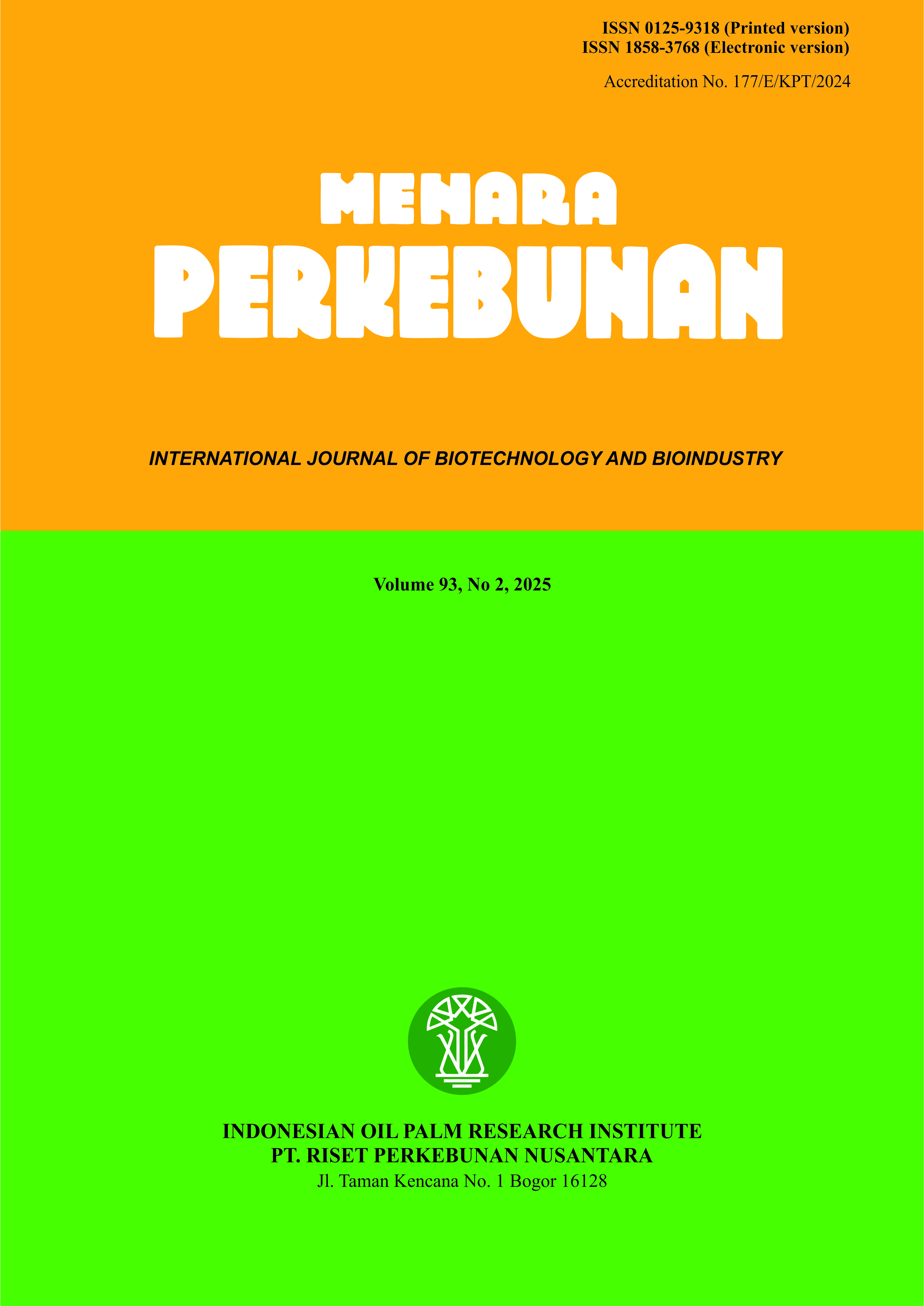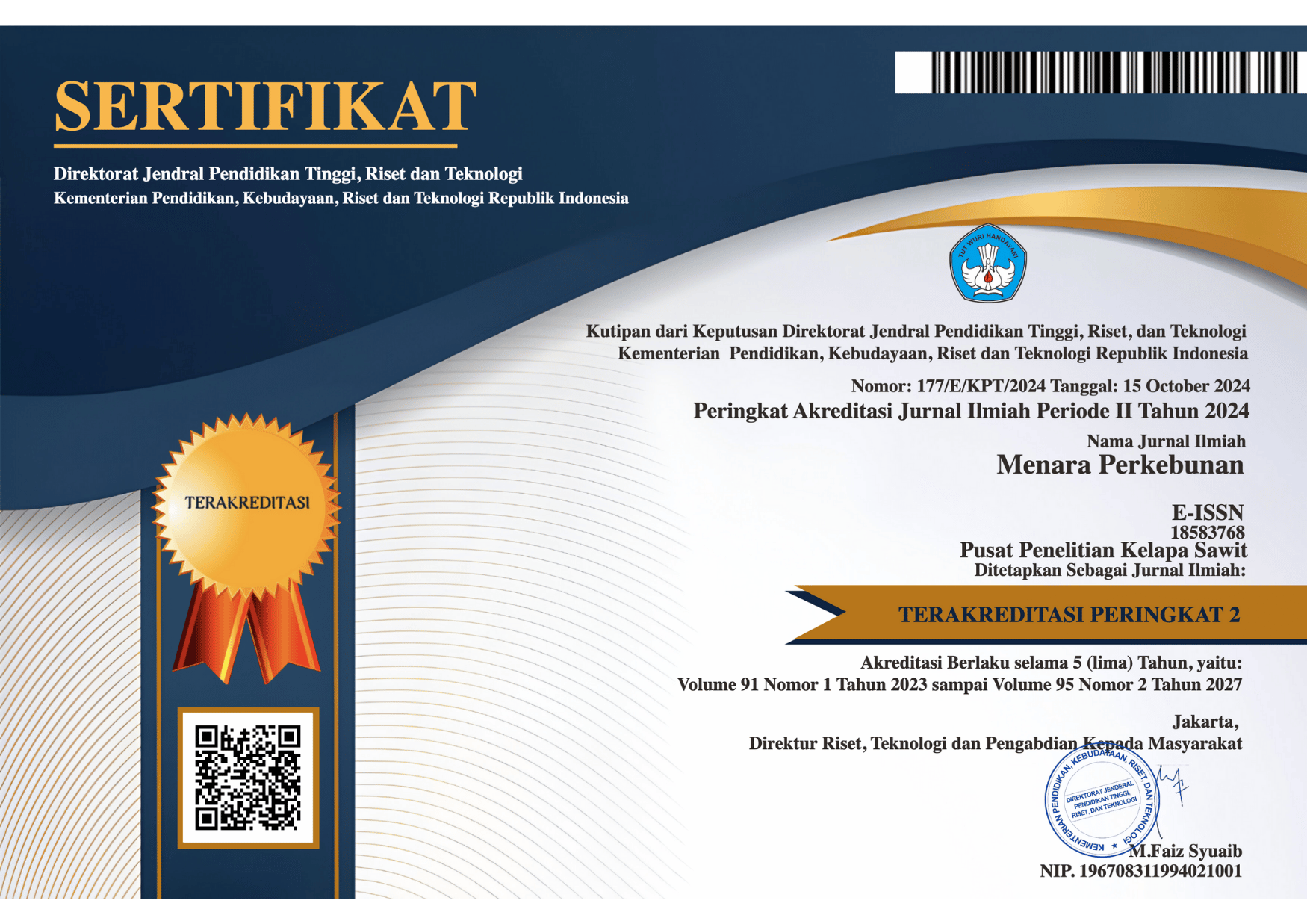Extraction and characterization of fulvic acid from oil palm empty fruit bunches
DOI:
https://doi.org/10.22302/iribb.jur.mp.v93i2.669Keywords:
CHN analyzer, FTIR, HNMR, microwave extractor, TGA-DSCAbstract
Oil palm empty fruit bunches (OPEFB) contain 27.78% lignin, which can serve as an alternative source of renewable fulvic acid, alongside soil and coal. This study aims to conduct the fulvic acid extraction process using a microwave extractor. The extraction process was carried out using H2O2 solvents with concentrations of 18, 21, and 24% and various sample types (OPEFB, shilajit, and commercial fulvic acid fertilizer), with three repetitions. The resulting liquid fulvic acid extract was then made into powder using freeze-drying. Quantitative testing was conducted using the spectrophotometric method, while qualitative testing employed Fourier-Transform Infrared Spectroscopy (FTIR), Proton Nuclear Magnetic Resonance (¹H NMR), spectrofluorometry, a CHN analyzer, and Thermogravimetric Analysis - Differential Scanning Calorimetry (TGA-DSC). The results showed that the best solvent concentration for the fulvic acid extraction process was H2O2, 21% of the total in the OPEFB sample. The highest fulvic acid content was found in the OPEFB sample at 23.59%; in the shilajit sample, it was 9.62%, and in the commercial fulvic acid fertilizer sample, it was 6.97%. The characterization results from spectrophotometric analysis, elemental analysis, and TGA-DSC analysis showed the potential of fulvic acid in the OPEFB sample, as it exhibited similarities with the analysis results of commercial fulvic acid (shilajit & commercial fulvic acid fertilizer).
Downloads
References
Asemani, M., & Rabbani, A. R. (2020). Detailed FTIR spectroscopy characterization of crude oil extracted asphaltenes: Curve resolution of overlapping bands. Journal of Petroleum Science and Engineering, 185, 106618. https://doi.org/10.1016/j.petrol.2019.106618
Dimawarnita, F., Maharani, K. Y., Faramitha, Y., Kalbuadi, D. N., Prakoso, H. T., Sari, I. P., & Goenadi, D. H. (2024). Optimization of fulvic acids production from oil palm empty fruit bunches using microwave extractor. Menara Perkebunan, 92(2), 141-152. https://doi/org/10.22302/iribb.jur.mp.v92i2.582
Doskočil, L., Burdíková-Szewieczková, J., Enev, V., Kalina, L., & Wasserbauer, J. (2018). Spectral characterization and comparison of humic acids isolated from some European lignites. Fuel, 213, 123-132. https://doi.org/10.1016/j.fuel.2017.10.114
Faramitha, Y., Dimawarnita, F., Cifriadi, A., Widiastuti, H., & Herawan, T. (2024). Fabrication and characterization of biocomposite pellets from cassava starch and oil palm empty fruit bunch fibers. Menara Perkebunan, 92(1), 82 - 89. https://doi.org/10.22302/iribb.jur.mp.v92i1.566
Gan, D., Kotob, S. I., & Walia, D. S. (2007). Evaluation of a spectrophotometric method for practical and cost effective quantification of fulvic acid. Annals of Environmental Science, 1, 11-15.
Gnananath, K., Nataraj, K. S., Rao, B. G., Kumar, K. P., Mahnashi, M. H., Anwer, M. K., & Mirza, M. A. (2020). Exploration of fulvic acid as a functional excipient in line with the regulatory requirement. Environmental Research, 187, 109642. https://doi.org/10.1016/j.envres.2020.109642
Gong, G., Xu, L., Zhang, Y., Liu, W., Wang, M., Zhao, Y., & Li, Y. (2020). Extraction of fulvic acid from lignite and characterization of its functional groups. ACS omega, 5(43), 27953-27961. https://doi.org/10.1021/acsomega.0c03388
Gunawan, R., & Nandiyanto, A. B. D. (2021). How to read and interpret 1H-NMR and 13C-NMR spectrums. Indonesian Journal of Science and Technology, 6(2), 267-298. https://doi.org/10.17509/ijost.v6i2.34189
He, X., Zhang, H., Li, J., Yang, F., Dai, W., Xiang, C., & Zhang, M. (2022). The positive effects of humic/fulvic acid fertilizers on the quality of lemon fruits. Agronomy, 12(8), 1919. https://doi.org/10.3390/agronomy12081919
Januari, A. D., & Agustina, H. (2022). Palm oil empty fruit bunches and the implementation of zero waste and renewable energy technologies. In IOP Conference Series: Earth and Environmental Science1034, (1), 012004. https: //doi.org/10.1088/1755-1315/1034/1/012004
Javed S, K Kohli & M Ali (2013). Microwave assisted extraction of fulvic acid from a solid dosage form: a statistical approach. Journal of Pharmaceutical Innovation, 8, 175–186. https://doi.org/10.1007/s12247-013-9157-y.
Jordaan, I. T. (2019). Synthesis, characterization and properties of fulvic acid, derived from a carbohydrate (Doctoral dissertation, Ph. D. Diss. NWU Lib. https://orcid. org/0000-0003-4221-582X).
Jozanikohan, G., & Abarghooei, M. N. (2022). The Fourier transform infrared spectroscopy (FTIR) analysis for the clay mineralogy studies in a clastic reservoir. Journal of Petroleum Exploration and Production Technology, 12(8), 2093-2106. https://doi.org/10.1007/s13202-021-01449-y.
Justi M, E Morais & C Silva (2019). Fulvic acid in foliar spray is more effective than humic acid via soil in improving coffee seedlings growth. Archives of Agronomy and Soil Science, 65(14), 1969-1983. https://doi.org/10.1080/03650340. 2019.1584396
Khan, R., Jain, P., Zakir, F., Aqil, M., Alshehri, S., Mirza, M. A., & Iqbal, Z. (2022). Quality and in vivo assessment of a fulvic acid complex: a validation study. Scientia Pharmaceutica, 90(2), 33. https://doi.org/10.3390/scipharm90020033
Mao Y. (2019). Modulation of the growth performance, meat composition, oxidative status, and immunity of broilers by dietary fulvic acids. Poultry Science, 98(10), 4509–4513. https://doi.org/10.3382/ps/pez281
Mindari, W., Sasongko, P. E., & Syekhfani, S. (2022). Asam humat sebagai amelioran dan pupuk. UPN “Veteran” Jawa Timur, Surabaya.
Moradi, S., Babak, P. & Talebi, R. (2019). Study of the effects of mycorrhiza, fulvic acid, seaweed extract and urea on physiological traits and leaf yield of tobacco (Burley 21). European Journal Environmental Science. 9(1), 33-40. https://doi.org/10.14712/23361964.2019.4.
Motojima, H., Yamada, P., Han, J., Ozaki, M., Shigemori, H., & Isoda, H. (2009). Properties of fulvic acid extracted from excess sludge and its inhibiting effect on β-hexosaminidase release. Bioscience, biotechnology, and biochemistry, 73(10), 2210-2216. https://doi.org/10.1271/bbb.90316
Ristiawan, A., & Syafila, M. (2015). Kinetika degradasi lignin dari limbah cair industri pulp and paper menggunakan advanced oxidation process (AOP) dengan kombinasi ozon dan hidrogen peroksida. Journal of Environmental Engineering ITB, 21(1), 48-56.
https://doi.org/10.5614/jtl.2015.21.1.6
Schellekens, J., Buurman, P., Kalbitz, K., Zomeren, A.V., Vidal-Torrado, P., Cerli, C., & Comans, R.N.J. (2017). Molecular features of humic acids and fulvic acids from contrasting environments. Environmental Science & Technology, 51, 1330–1339. https://doi.org/10.1021/acs.est.6b03925
Tan, K. H. (2010). Principles of soil chemistry. CRC Press.
Zhang, A., Zhang, Y. J., Zheng, H. L., Ma, L. L., Liu, W. J., & Gong, G. Q. (2018). Study on the extraction of fulvic acid from lignite by microwave-assisted hydrogen peroxide. International Journal of Oil, Gas and Coal Technology, 18(1-2), 146–162.
Zhang, P., Zhang, H., Wu, G., Chen, X., Gruda, N., Li, X., & Duan, Z. (2021). Dose-dependent application of straw-derived fulvic acid on yield and quality of tomato plants grown in a greenhouse. Frontiers in plant science, 12, 736613.
Zhang, Y., Du, J., Ding, X., & Zhang, F. (2016). Comparison study of sedimentary humic substances isolated from contrasting coastal marine environments by chemical and spectroscopic analysis. Environmental Earth Sciences, 75(5), 378. https://doi.org/10.1007/s12665-016-5263-8
Zhang, Y., Gong, G., Zheng, H., Yuan, X., & Xu, L. (2020). Synergistic extraction and characterization of fulvic acid by microwave and hydrogen peroxide–glacial acetic acid to oxidize low-rank lignite. ACS omega, 5(12), 6389-6394.
Zuidar, A. S., Hidayati, S., & Pulungan, R. J. A. (2014). Kajian delignifikasi pulp formacell dari tandan kosong kelapa sawit menggunakan hidrogen peroksida (H2O2) dalam media asam asetat. Jurnal Teknologi & Industri Hasil Pertanian, 19(2), 194-204.
Downloads
Submitted
Accepted
Published
How to Cite
Issue
Section
License
Copyright (c) 2025 Firda Dimawarnita, Khairy Yunda Maharani, Sutanto Sutanto, Yora Faramitha, Donny Nugraha Kalbuadi, Didiek Hadjar Goenadi

This work is licensed under a Creative Commons Attribution 4.0 International License.
Authors retain copyright and grant the journal right of first publication with the work simultaneously licensed under a Creative Commons Attribution License that allows others to share the work with an acknowledgement of the work's authorship and initial publication in this journal.













